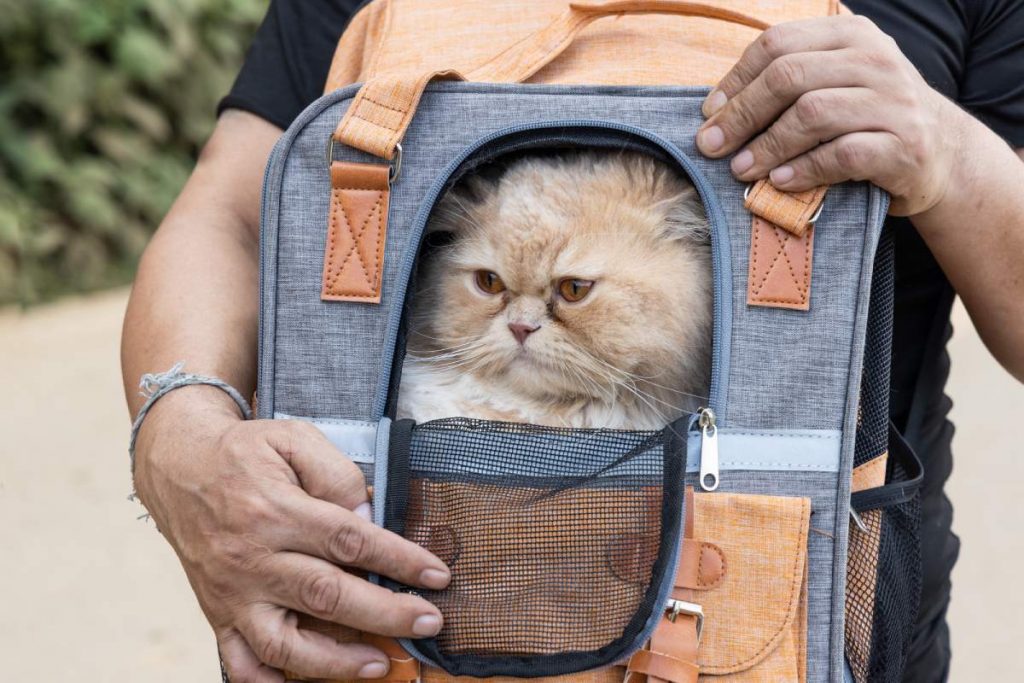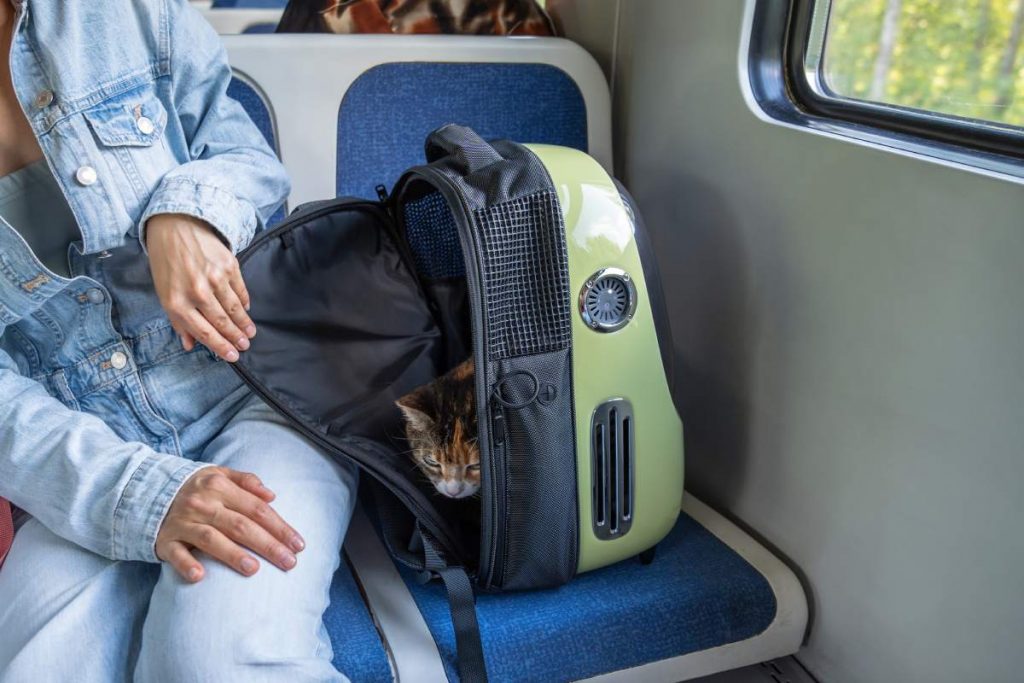Picking the right carrier for your cat is super important for their comfort and well-being while travelling, whether it’s a long journey or your cat accidentally eats your chocolate and needs to go to the vet. In any case, you need the most comfortable pet carrier for your cat, don’t you?
In this guide, we’ll check out the pros and cons of hard versus soft carriers and share practical tips on how to make sure your cat is comfy while in the carrier.
Is a Hard or Soft Carrier Better For a Cat?
When deciding between a hard or soft carrier for your cat, it’s important to consider various factors to ensure your feline friend’s comfort and safety. Both types have their advantages, so let’s break down the key aspects of each to help you make the best choice for your cat.
Hard Carriers
1. Durability and Safety
Hard carriers are typically made from plastic or metal and are known for their durability. They provide excellent protection during travel, which is particularly beneficial if you need to transport your cat to the vet or during long trips. The solid structure ensures that the carrier won’t collapse or get damaged easily, keeping your cat secure inside.
2. Easy to Clean
One of the main benefits of hard carriers is that they are easy to clean. Most models come with a removable bottom tray, which can be washed separately. This feature is useful for maintaining hygiene, especially if your cat has an accident or spills food or water inside the carrier.
3. Better Ventilation
Hard carriers usually have better ventilation compared to soft carriers. They often feature multiple air vents or openings, ensuring that your cat gets adequate airflow during travel. This is important for keeping your cat cool and comfortable.
4. More Space
Many hard carriers are designed with more space and have a more rigid structure, which can give your cat more room to move around. This can be particularly advantageous if you have a larger cat or need to carry additional supplies like food or water.
5. Assembly
Some hard carriers can be more challenging to assemble or disassemble, especially those with complex locking mechanisms. Ensure you choose a model that is easy to handle, especially if you need to frequently open and close it.

Soft Carriers
1. Portability and Convenience
Soft carriers are typically made from fabric and are lighter and more portable than hard carriers. They often have adjustable shoulder straps, which make them easier to carry, especially if you need to transport your cat over longer distances. Soft carriers can also be easier to store when not in use because they can be folded flat.
2. Comfort
Soft carriers often have padded interiors, which can provide additional comfort for your cat. The fabric material can be softer and more flexible, allowing your cat to snuggle in and feel secure. Some models also feature mesh panels that allow your cat to see out and interact with their surroundings.
3. Flexibility
The flexible nature of soft carriers allows them to fit into smaller spaces, such as under aeroplane seats or in tight car spots. This flexibility can be useful for travel and ensures that the carrier can adapt to different environments.
4. Easy Access
Many soft carriers have multiple access points, such as zippers on the top or sides. This makes it easier to put your cat inside or take them out, especially if they are nervous or unwilling to enter the carrier voluntarily.
5. Less Protection
One downside to soft carriers is that they offer less protection compared to hard carriers. They are not as sturdy, which might be a concern if you need to transport your cat in rough conditions or if the carrier is subject to rough handling.
Consider your cat’s personality and your lifestyle when making your decision. If your cat is anxious about travel, a soft carrier with a padded interior might help them feel more secure. If you’re looking for durability and ease of cleaning, a hard carrier might be the better option.
Do Cats Prefer Small or Large Carriers?
Cats generally prefer carriers that are just the right size for them—neither too small nor too large. Here’s a breakdown of what to consider when choosing the size of a carrier for your cat:
Ideal Size for a Cat Carrier
1. Comfort and Security
Cats tend to feel more secure in a carrier that isn’t too large. A carrier that is too big can make them feel exposed and less secure, while one that is too small can be uncomfortable and cramped. The ideal carrier should be large enough for your cat to stand up, turn around, and lie down comfortably, but not so large that they feel lost inside.
2. Stress Reduction
A carrier that is the right size can help reduce your cat’s stress. Cats often seek out small, enclosed spaces because they feel safe and secure in them. A carrier that closely fits their body size can mimic this environment and help your cat feel more at ease.
3. Safety and Stability
A carrier that is too large can be less stable, especially when moving or travelling. A carrier that fits your cat snugly helps prevent them from sliding around, which can reduce anxiety and make the journey smoother.
4. Space for Essentials
While the carrier should be appropriately sized, it should also allow enough space for a small blanket or bed to make it more comfortable. If you need to transport food, water, or a litter box, ensure the carrier has enough room to accommodate these items without making it too cramped.

Measuring Your Cat
To find the right size, measure your cat from the tip of their nose to the base of their tail and from the floor to the top of their head while they’re sitting. Use these measurements to choose a carrier that gives them a bit of extra room beyond their actual size.
Carrier Types and Sizes
1. Small Carriers
Smaller carriers are usually more suitable for cats that prefer close quarters and for short trips. They are also easier to carry and manoeuvre, making them a good choice for quick vet visits.
2. Medium to Large Carriers
These carriers offer more space and are useful for longer trips or for cats that prefer a bit more room. They can also be helpful if you need to transport additional items like a blanket or toy to comfort your cat.
In summary, a carrier that is the right size for your cat—providing enough space for them to be comfortable but not so much that they feel insecure—is usually the best choice. Each cat is different, so observe your cat’s preferences and behaviour to determine the ideal carrier size for their needs.
How Long Should My Cat Stay in a Carrier?
The amount of time your cat should stay in a carrier depends on several factors, including the purpose of the trip, the distance, and your cat’s tolerance for confinement. Here’s a guide to help you determine how long your cat should stay in a carrier and how to make the experience as comfortable as possible:
Short Trips (Up to 30 Minutes)
For quick trips, such as a visit to the vet or a short car ride, your cat may be in the carrier for 10 to 30 minutes. Here are some tips for short trips:
- Comfort: Ensure the carrier has a soft, comfortable bedding or blanket to help your cat feel secure.
- Calm Environment: Keep the environment calm by speaking softly to your cat and minimizing sudden movements or loud noises.
- Hydration: If you’re travelling during warm weather, consider offering a small amount of water before and after the trip.
Medium Trips (30 Minutes to 1 Hour)
For trips lasting up to an hour, such as longer car rides or extended visits:
- Breaks: If possible, take short breaks to check on your cat and allow them a few minutes outside the carrier if it’s safe to do so.
- Ventilation: Ensure the carrier is well-ventilated to keep your cat comfortable and avoid overheating.
- Comfort Items: Include familiar items like a favourite toy or blanket to provide comfort and reduce stress.

Long Trips (Over 1 Hour)
For trips longer than an hour, such as cross-country travel or extended stays:
- Comfort and Safety: Make sure the carrier is spacious enough for your cat to move around and lie down comfortably. For very long trips, consider using a carrier with additional features like a padded floor or built-in food and water compartments.
- Regular Checks: Stop periodically to check on your cat’s well-being, and if feasible, provide them with food and water.
- Stress Reduction: Familiarize your cat with the carrier before the trip by allowing them to explore and use it at home. This can help reduce anxiety during the actual journey.
General Tips for All Trips
- Acclimation: Before the trip, let your cat get used to the carrier by placing it in a familiar space and allowing them to explore it. This can make the carrier seem less intimidating.
- Exercise: Ensure your cat has had some exercise before being placed in the carrier. This can help them feel more relaxed during the trip.
- Monitor Behavior: Pay attention to your cat’s behaviour and stress levels. If they seem very anxious or distressed, consider consulting your vet for advice on how to make the journey more comfortable.
Overall, while the time your cat spends in the carrier can vary, making the experience as comfortable and stress-free as possible is key. If you’re planning a particularly long journey or your cat has specific health concerns, consult with your vet for tailored advice.
In Summary
Choosing the right carrier and managing your cat’s time inside it is key to a calm travel experience. Hard carriers are great for their sturdiness and safety, while soft carriers are all about comfort and ease of carrying. Make sure the carrier fits your cat just right and feels cosy.
On longer journeys, keep your cat feeling safe and check in often to reduce their stress. Stick to these tips, and you’ll make travelling a breeze for your furry friend.





